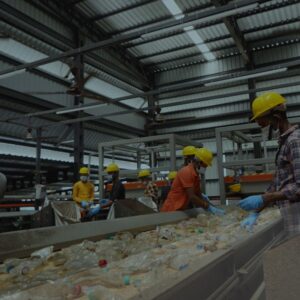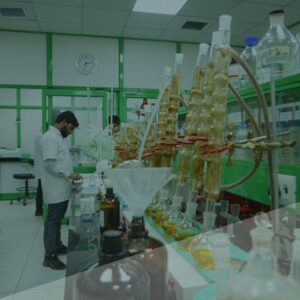Home / Recycling Decoded: Answering FAQs on How Plastic Waste Becomes a Resource
We talk a lot about plastic pollution, but plastic solutions? Recycling is one of the most important methods of keeping plastic in circulation and out of the environment, but how does it work?
At JB rPET, we step in to make the process simpler and efficient. Here in this blog, we deconstruct the process, resolve frequently asked questions, and identify how plastic waste can be granted a second purpose rather than having it burden the earth.

1. What happens to a PET bottle after it’s discarded?
Once a PET bottle is thrown away, its life isn’t over, it has just begun. If it ends up in the right recycling stream, it’s sorted and cleaned and then made into rPET, which is integrated into new products. If it’s simply discarded carelessly, it remains on our planet for hundreds of years, breaking down into microplastics that infiltrate our world.2. What types of plastics can be recycled?
Plastics are sorted into seven resin identification codes, yet not all of them are equally recyclable. PET (Polyethylene Terephthalate), used for beverage bottles and food containers, is one of the most recyclable plastics. HDPE (High-Density Polyethylene), used in detergent bottles and milk jugs, is also extensively recycled. Others such as PP (Polypropylene) and LDPE (Low-Density Polyethylene) have restricted recyclability, subject to local facilities. In JB rPET, we are emphasizing recycling PET due to its value and usability multiple times without quality loss. The success of recycling, however, relies on accurate sorting—clear PET can be used for any purpose, whereas coloured or impure plastics cause difficulties.
3. How does the recycling process work at JB rPET?
After being collected, PET trash is washed, sorted, and processed with great care. At JB rPET, we use advanced technology to purify PET from other waste, yielding high-purity recycled products. The plastic is shredded into flakes or manufactured as rPET resin, which can be utilized to make new bottles, food packaging, and fashion.
4. How do contamination and incorrect sorting affect recycling?
 Contamination, for example, food waste, labels, and sorted plastic types, can hamper the quality of recycled PET. Poor sorting causes processing issues and can lead to waste instead of reuse. JB rPET is therefore keen on the importance of clean and well-sorted PET waste. We employ rigorous sorting methods to make sure that high-quality materials alone are fed into the recycling system.
Contamination, for example, food waste, labels, and sorted plastic types, can hamper the quality of recycled PET. Poor sorting causes processing issues and can lead to waste instead of reuse. JB rPET is therefore keen on the importance of clean and well-sorted PET waste. We employ rigorous sorting methods to make sure that high-quality materials alone are fed into the recycling system.
5. Why is clear PET preferable over coloured PET?
Clear PET is the most recyclable, as it can be converted into more products with good quality. Coloured PET, particularly green bottles, is very challenging to recycle through the entire process. In order to be efficiently processed, recyclers like JB rPET require separate streams of different coloured bottles; unless presorted, green PET is difficult to process and results in inefficiencies. Moreover, green PET has minimal reuse value—it is recycled largely to black or green-coloured fibre and cannot be remade back to bottle-to-bottle-grade chips, making its use less appropriate. Not only does this result in undesirable fibre production, but it also costs recyclers a financial burden. Removal of coloured PET from the system would make recycling easier, minimize operational challenges, and improve the efficiency of an actual circular economy.
6. Is rPET safe for food packaging?
Indeed, rPET is food-safe packaging if it has been processed well. It’s essential to trust rPET suppliers who maintain extremely strict measures of safety and quality. We hold USFDA certification, highlighting that our rPET has undergone extensive processing, is free of toxic substances, and can safely be utilized for food-grade purposes7. What are some criticisms of plastic recycling, and how are they being addressed?
Plastic recycling has been criticized for problems such as downcycling, collection and sorting inefficiencies. At JB rPET, we tackle these challenges using cutting-edge recycling technologies, rigorous quality control, and an emphasis on upcycling over downcycling. Our method guarantees that rPET is converted into materials that are not any less in value and functionality. Through ongoing innovation and a focus on circularity, we are redefining the industry, we are demonstrating that plastic waste, when managed properly, can be a resource, not an issue.8. How does JB rPET ensure the quality and purity of recycled PET?
At JB rPET, purity and quality are non-negotiables. We strictly implement quality control standards during production to guarantee our recycled PET resins are at par with industry specifications and requirements. Our extensive sorting and washing procedures remove contaminants, while our highly advanced laboratory with the newest technology in testing ensures rigorous purity, consistency, and performance analysis. Each batch is thoroughly tested to ensure that it is ready for use in different applications so that our rPET is safe and reliable.
9. What sustainability certifications does JB rPET hold?
Along with USFDA, our commitment to excellence is also attested to by the following certifications:- GRS: The Global Recycled Standard certification confirms environmentally responsible processes, educates on the environmental and ethical standards of the recycling process, and ensures transparency and accountability in all supply chains.
- Oeko Tex: One of the most well-regarded certifications to indicate that our products comply with very high international safety standards, including being completely free from all harmful substances and therefore safe for consumers to use.









